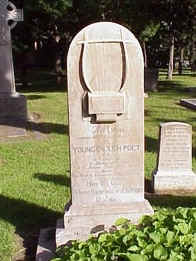|
John Keats is buried in the Protestant Cemetery, Rome, Italy. His grave
is in a quiet corner close to the Pyramid. (Shelley
is
also buried in this cemetery.)

Gravestone of John Keats

Grave of Keats and Severn
After leaving
Clarke's school in Enfield, Keats became apprenticed to Thomas Hammond -
an apothecary-surgeon in Edmonton. In 1814 he left Hammond and began
studying at St. Thomas's and Guy's Hospitals. It was at this time that
he began to write poetry - influenced, in particular, by
Spenser and Milton.
In 1816 he became licensed to practice as an apothecary but abandoned it
to take up poetry full time. Blackwood's Magazine - pejoratively
referred to this decision as Keats joining the
Cockney School
of poetry. At this time Keats met with many of the leading poets and
artists of the day including: Leigh Hunt, Shelley,
Wordsworth, Charles Lamb and Benjamin Haydon.
In 1819 he became engaged to Fanny Brawne but by the winter of that year
he had started to develop tuberculosis. Keats left England in 1820, on the advise of his doctors, and
headed for Italy with his friend Joseph Severn. By now, he was in the final stages of consumption. He arrived at Naples and
then proceeded to Rome where he rented a house on the Spanish Steps. He died on the 23 February, 1821
aged only 25.
Keats requested that only the phrase:
Here lies One Whose Name was writ in Water
be inscribed on his headstone. However, his two close friends Joseph Severn and Charles Brown,
who cared
for him during his illness, decided to add the following:
This Grave contains all that was
mortal, of a YOUNG ENGLISH POET, who on his Death Bed, in the Bitterness of his
heart, at the Malicious Power of his enemies, desired these words to be Engraven on
his Tomb Stone
Brown and Severn felt that Keats
had been badly treated by the critics - in particular by harsh reviews of
Endymion which appeared in Blackwood's and the
Quarterly Review. However, both men later
regretted adding their own words to the headstone. Severn is buried near to Keats and between them lies Severn's
son. Shelley
wrote a long elegy
for Keats entitled Adonais.
|







